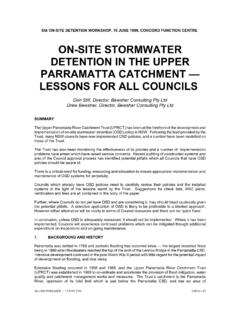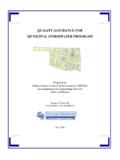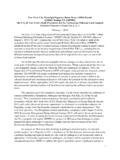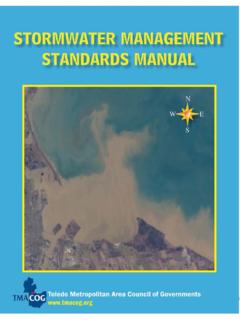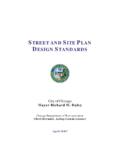Transcription of Hydraulic Analysis Guidance Document - Connecticut
1 STATE OF Connecticut . DEPARTMENT OF ENVIRONMENTAL PROTECTION. BUREAU OF WATER MANAGEMENT. INLAND WATER RESOURCES DIVISION. Hydraulic Analysis Guidance Document Supplemental Guidelines for Preparing Riverine Hydraulic Analyses in Permit Applications Submitted to the Inland Water Resources Division Including: Inland Wetlands and Watercourses Permits Stream Channel Encroachment Line Permits 401 Water Quality Certifications Water Diversion Permits Dam Construction Permits Flood Management Certification Approvals Printed on Recycled Paper DEP-IWRD-GUID-100 1 of 12 Rev. 01/26/05. Hydraulic Analysis Guidance Document Table of Contents Section 1. Purpose Of Note to When is a Hydraulic Analysis Required?..3. Section 2. Governing Section 3. Fundamentals in Modeling River Hydraulics ..5. Existing Conditions Natural Conditions Proposed Conditions Section 4. Summary and Presentation of Section 5. Other Important Considerations.
2 10. DEP-IWRD-GUID-100 2 of 12 Rev. 01/26/05. Section 1. Introduction Purpose of Guidelines These guidelines have been prepared by the Inland Water Resources Division (IWRD) to assist engineers in the preparation of engineering reports where Hydraulic modeling is required. Such engineering reports are required to be submitted with IWRD permit applications for projects that fall within the IWRD's jurisdiction. Specifically, these guidelines detail the documentation necessary to demonstrate that a project is in compliance with the requirements of the State of Connecticut Flood Management Statutes and Regulations (Sections 25-68b through 25-68h of the Connecticut General Statutes [CGS] and Sections 25-68h-1 through 25-68h-3 of the Regulations of Connecticut State Agencies [RCSA]) applicable statutes and regulations. It also details the preferred format in which the documentation should be submitted to the Department of Environmental Protection (DEP).
3 It does not include the modeling requirements for open channel modifications, storm drainage systems, or stormwater detention facilities. Further information on these specific types of projects may be found in RCSA Section 25-68h-3. Note to Users These guidelines are intended for persons with a background in Hydraulic modeling, therefore it is assumed that technical terms are generally understood and do not need to be explained. Applicants should remember that these guidelines have been prepared to outline a suggested format for documenting and presenting your modeling work and are not intended to provide training in the design of bridges, roadways, commercial site development, or wetlands mitigation. Compliance with these guidelines does not create a presumption that your project will be approved. Applicants should review all applicable statutes and regulations prior to preparing an application, including, where applicable, the provisions of the coastal management statutes, Chapter 444 of the general statutes.
4 When is a Hydraulic Analysis Required? In any case where changes are proposed in a floodplain or in a watercourse which may affect the conveyance of flood flows, Hydraulic information as outlined in this report is required. This includes but is not limited to; bridge/culvert replacements or relocations of any kind, bridge superstructure replacement if the Hydraulic opening of the bridge is changed in any way, channel modifications including the placement of bank stabilization material, fill placed in a floodplain, excavation in a floodplain, or any combination of fill and excavation. The complexity of the Analysis depends on whether special circumstances exist, such as the presence of a Federal Emergency Management Agency (FEMA) floodway or stream channel encroachment lines (SCEL) at the site. Section 2. Governing Policies The following statutes and regulations establish the Flood Management policies and practices of the DEP: State of Connecticut Flood Management Statutes and Regulations (CGS Sections 25-68b through 25-68h and RCSA Sections 25-68h-1 through 25-68h-3).
5 All applications for permits in the programs administered by the IWRD are reviewed to insure that the proposed activities are in conformance with applicable flood management standards and criteria. DEP-IWRD-GUID-100 3 of 12 Rev. 01/26/05. National Flood Insurance Program (NFIP) (44 CFR, Chapter 1, Subchapter B, Part ). The NFIP standards and criteria are the basis for the minimum requirements of the State's Flood Management Program. Inland Wetlands and Watercourses (CGS Section 22a-39 through 22a-45a), Dam Construction (CGS Section 22a-401 through 22a-411), Water Diversion (CGS Section 22a-365 through 22a-379a), Water Quality Certifications under Section 401 of the Federal Clean Water Act (33 USC 1341), and Stream Channel Encroachment (CGS Sections 22a- 342 through 22a-349). These programs regulate Connecticut 's inland water resources. Applications for permits in these programs are evaluated for environmental and flooding impacts.
6 CGS Section 13a-94 requires that all structures built over or adjacent to streams in connection with state highway projects conform to the Stream Channel Encroachment Program requirements. Most communities in Connecticut have adopted Flood Insurance Rate Maps and Floodway maps in conjunction with the NFIP administered by the FEMA for use in regulating development within floodplains. Many streams and rivers in these communities have been studied for the purpose of defining a flood plain area and a floodway area. The floodway is the central part of the floodplain that is reserved to ensure that a sufficient part of the flood plain will remain open to carry flood waters efficiently. The following are some of the standards and criteria which must be met in order for a project to be consistent with the State's Flood Management Policies: Floodplains. RCSA Section 25-68h-2(c)(1) prohibits any activity in a floodplain which would adversely affect the Hydraulic characteristics of the floodplain.
7 This includes floodplains in both inland areas and coastal areas. All permit applications for projects proposed within a floodplain must demonstrate that the project will not cause adverse impacts to upstream, downstream, or adjacent properties. Floodways. RCSA Section 25-68h-2(c)(5) and Section (d)(3) of NFIP regulations prohibit any activity within a regulatory floodway which would result in any increase in the base flood water surface elevation. In order for any proposed project which does not meet these standards to be approved, a map revision is required from FEMA. 10-Year Profiles. RCSA Section 25-68h-2(c)(5) prohibits any activity within a regulatory floodway which would result in an increase in the elevation of the 10-year water surface profile. DEP-IWRD-GUID-100 4 of 12 Rev. 01/26/05. Stream Channel Encroachment Lines. The State of Connecticut has established Stream Channel Encroachment Lines (SCELs) on approximately 270 miles of flood prone rivers in the state.
8 This program differs from the Flood Management Certification program in the scope of review and the extent of jurisdiction, as well as the base flood elevations and discharges for individual watercourses. Maps showing the regulated areas are on file with the IWRD and are also on file in the Town Clerk's offices in each town where lines have been established. CGS Section 22a-342 requires that the DEP evaluate proposed encroachments based on the flood-carrying and water storage capacity of the waterways and floodplains, flood heights, hazards to life and property, and the protection and preservation of the natural resources and ecosystems of the state, including but not limited to ground and surface water, animal, plant, and aquatic life, nutrient exchange, and energy flow, with due consideration given to the results of similar encroachments constructed along the reach of waterway. Natural Profile. Bridges and culverts should be designed so that the proposed water surface profile does not exceed the natural profile by more than one foot for the 100-year or SCEL floodplain Analysis .
9 This applies to the replacement of existing bridges and culverts as well as the construction of new structures. If the proposed profile does not meet this standard, documentation must be submitted justifying the basis for the design. This standard does not apply to DOT Flood Management Certifications for projects which have a drainage area of less than one square mile. These projects have been exempted by regulation from Flood Management standards. Notwithstanding the above, any increase over the existing water surface elevations will only be permitted provided no adverse impacts are created. Water Resources. The project should not adversely affect the environment or long range water resource planning or impair proper management and use of the water resources of the State. Fish Habitat. The project must provide for adequate fish passage and maintenance of fish habitat in watercourses which may support fish. DEP Fisheries should be contacted in advance for technical advice for any project which may impact fisheries Section 3.
10 Fundamentals in Modeling River Hydraulics Selection of Computer Modeling Programs. Most Hydraulic models used in support of permit applications are one-dimensional models for calculating water surface profiles which assume steady gradually varied flow. Programs such as HEC-2, HEC-RAS, WSP2 and WSPRO are all acceptable models, since these are models which are in the public domain and can be recreated for review. In general, no other models should be submitted to the IWRD. Other models may be acceptable, with prior approval from DEP, provided they use the standard step method of solving the Energy Equation: WS2 + a 2V22/2g = WS1 + a 1V12/2g + he DEP-IWRD-GUID-100 5 of 12 Rev. 01/26/05. Unique situations may require specialized modeling, such as two- or three- dimensional models. If you are not using one of the above listed models, you must consult with the IWRD before submitting your application. The models used by FEMA to map floodplains assume subcritical flow and applicants recreating a FEMA study should apply the same assumption.











